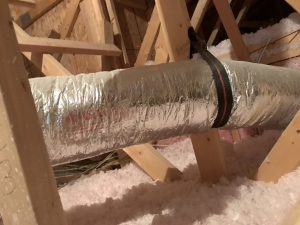 Functional, efficient duct design is as vital to effective heating and cooling as a home’s furnace and air conditioning units. Proper distribution of conditioned air inside a house is a carefully calculated balancing act. The U.S. Department of Energy states that poorly designed and/or improperly installed ductwork can reduce the efficiency of an overall HVAC system by as much as 40%. What’s worse, the resultant higher heating and cooling costs, inconsistent comfort and poor indoor air quality will persist as long as the ductwork is installed in the house.
Functional, efficient duct design is as vital to effective heating and cooling as a home’s furnace and air conditioning units. Proper distribution of conditioned air inside a house is a carefully calculated balancing act. The U.S. Department of Energy states that poorly designed and/or improperly installed ductwork can reduce the efficiency of an overall HVAC system by as much as 40%. What’s worse, the resultant higher heating and cooling costs, inconsistent comfort and poor indoor air quality will persist as long as the ductwork is installed in the house.
That’s why getting duct design right is critical from the very start. “Rule-of-thumb” guesstimates don’t meet today’s high standards. A qualified HVAC contractor will access industry-standard software to calculate the exact cooling and heating load requirements of the house. Then, a separate program called Manual D is utilized to size the ductwork and ensure that the precise volume of airflow reaches every room, according to its specific square footage and distance from the central air handler/blower.
Other basics of duct design to optimize heating and cooling include these principles:
Ducts routed through unconditioned zones of the house such as the attic or crawl space are subject to heat gain or loss and must be insulated. Wherever possible, ductwork should be routed through the conditioned envelope of the house.
Design should keep duct spans as short as possible to reduce air friction. The number of sharp bends in ductwork that impede airflow should also be minimized.
Manual dampers installed in branch ducts are necessary to balance air pressure in each room. Both over-pressurized and under-pressurized rooms waste heating and cooling and underperform in both comfort and air quality.
Where a central return duct is installed instead of individual returns in each room, there must be an unobstructed path for continuous air flow from each supply duct to the central return.
Ducts must be properly sealed at all joints with mastic and metal tape, then pressure-tested to verify that leakage is within standards.
For a professional approach to efficient, effective duct design, contact Ace Hardware Home Services.
Our goal is to help educate our customers in Dayton, Ohio about energy and home comfort issues (specific to HVAC systems).







